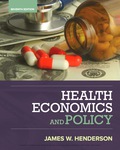In the basic model of insurance, income is the only input into a person’s utility. This is obviously not realistic. If we relax our assumption that utility is determined only by income levels, can any insurance contract provide full protection against the possibility of becoming severely ill? Give examples of risks associated with becoming sick that are not typically covered by formal health insurance. Can you think of ways that people informally insure against these “uninsurable” risks?
In the basic model of insurance, income is the only input into a person’s utility. This is obviously not realistic. If we relax our assumption that utility is determined only by income levels, can any insurance contract provide full protection against the possibility of becoming severely ill? Give examples of risks associated with becoming sick that are not typically covered by formal health insurance. Can you think of ways that people informally insure against these “uninsurable” risks?
Chapter5: Demand For Health And Medical Care
Section: Chapter Questions
Problem 3QAP
Related questions
Question
In the basic model of insurance, income is the only input into a person’s utility. This is obviously not realistic. If we relax our assumption that utility is determined only by income levels, can any insurance contract provide full protection against the possibility of becoming severely ill? Give examples of risks associated with becoming sick that are not typically covered by formal health insurance. Can you think of ways that people informally insure against these “uninsurable” risks?
Expert Solution
This question has been solved!
Explore an expertly crafted, step-by-step solution for a thorough understanding of key concepts.
This is a popular solution!
Trending now
This is a popular solution!
Step by step
Solved in 2 steps

Knowledge Booster
Learn more about
Need a deep-dive on the concept behind this application? Look no further. Learn more about this topic, economics and related others by exploring similar questions and additional content below.Recommended textbooks for you

